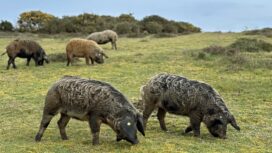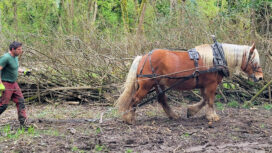Diggers are all set to move in and break up the concrete base of the old Middle Beach cafe at Studland in Dorset, as the next step in returning the much loved beauty spot to its natural state.
Concrete foundations of the now demolished cafe and toilets, which had stood above the beach for a century, will be removed between Monday 11th September and Monday 25th September 2023.
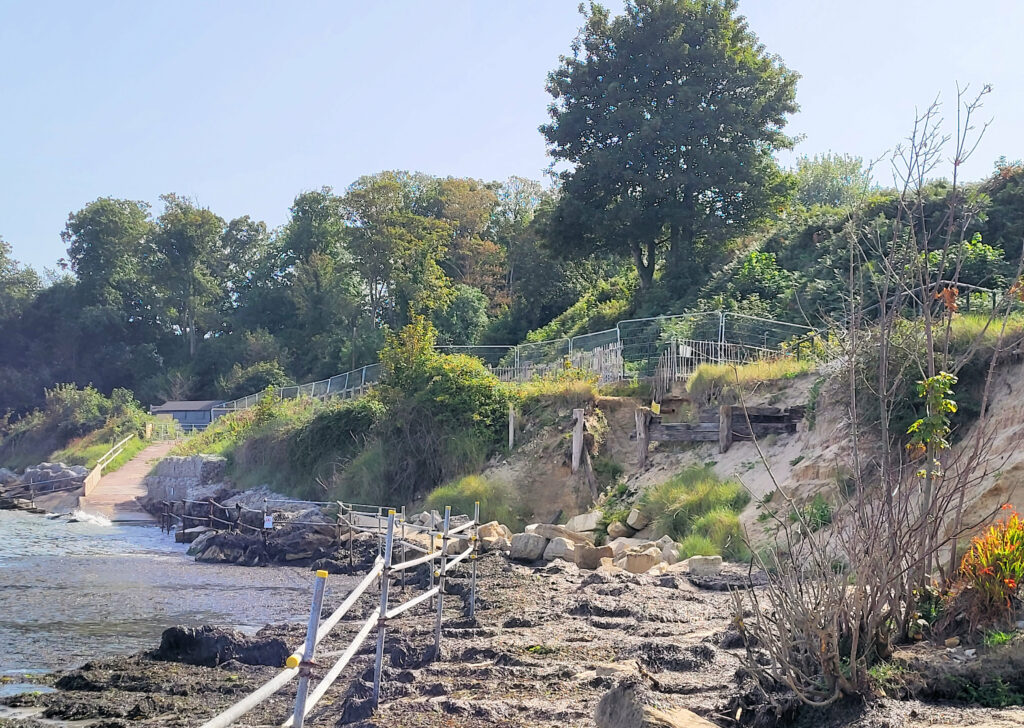
Foundations of the former cafe and toilets are already exposed to the sea
Expected to become a natural cove
The final phase of work, to remove man made sea defences including stone gabion baskets which are beginning to collapse, is expected to be carried out in 2024, allowing Middle Beach to become a natural cove.
Change is expected to be both quick and noticeable as wave action will bring down the soft cliffs and start to replenish the beach with sand within months.
Despite criticisms in the national press that Middle Beach had been left like a “bomb site” and a “horror show” over the summer, the managed retreat policy in Studland has been planned around visitors and Purbeck’s rare sand lizards, which nest, lay eggs and raise young in the area.
Now, with the edge of the former cafe foundations just a few feet from waves at high tide, the National Trust says the time is right to let nature remodel the beach – and locals and visitors could be very pleasantly surprised by the outcome.
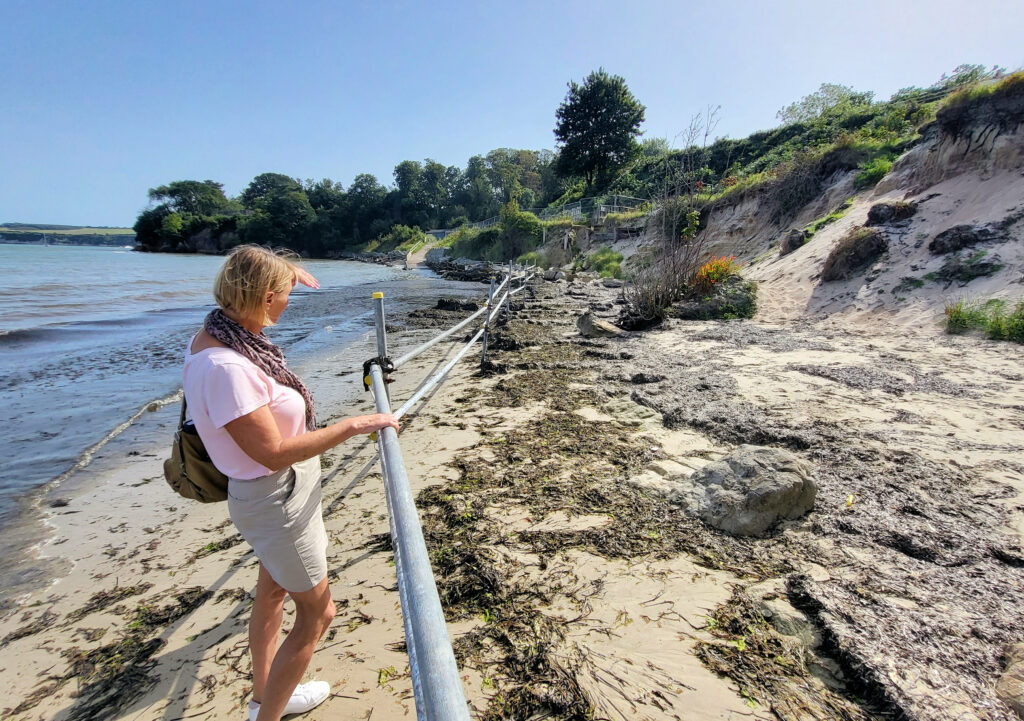
Wave action is already reshaping the beach and is likely to speed up dramatically through the winter
Locals want to see facts, not clickbait
Tracey Churcher, National Trust general manager for Purbeck, said:
“We had to remove the buildings because erosion was chipping away at the cliff underneath them and they would have become hazardous.
“One of the criticisms we have had is that the cafe was nowhere near the cliff edge, but the tide is now over the edge of its boundary most of the time, and the former toilet block already has one leg over the edge.
“Local people want to see detail, not clickbait by the national and regional newspapers. For the rare lizards which nest and lay their eggs in this area and for the visitors who come here for the quiet enjoyment of the beach, it made sense to pause the work during the summer months.
“Now we will pick up again, working mostly during the week and minimising impact at weekends, but it will only be for two weeks for the top part of the undercliff.
“I think people who live and visit here will be pleased to have this work done, and the transition hasn’t been as bad as they feared because they did have a lovely new cafe within two weeks of the old one closing.”

The hardstanding for the old Middle Beach cafe will disappear as the area becomes a natural cove
“We are not the faceless National Trust”
Tracey Churcher added:
“I understand that Studland Bay is a landscape of people’s hearts and when they see change and it’s not immediately obvious why that change is happening, it’s easy to jump to the conclusion that the area is being mindlessly desecrated.
“The people who work for the National Trust are local people who live and work in this area and love and care for it as much as the people who visit it – no action is taken without thought, without consultation and without care.
“It matters deeply to us – we are not the faceless National Trust, we are just a large local employer of nearly 400 between staff and volunteers in Purbeck, and that’s a lot of people who care, there’s always a good reason for the things that we do.”
The decision to close the original Middle Beach Cafe and let the sea reclaim the beach was based on a national government policy from 2005 of adapting to climate change along the coast rather than fighting it.

A new, shorter path down to the sea is one of the improvements at Middle Beach
Studland management plan on the way
The Middle Beach cafe, which had stood on the site since at least 1904, has now been replaced with the Sandy Salt Pig which sits well back from the clifftop with glorious views over the bay.
The original zigzag access to Middle Beach has been extended, making an easier and shorter route down to the sea for people with watersports equipment, new bike racks and new hammocks have been introduced and areas of vegetation have been left uncut to allow wild flowers to grow.
The long term location of the Sandy Salt Pig will be part of a much larger Studland management plan which will go out for consultation in 2024, similar to the seafront master plan for Swanage.
Knoll Beach and its cafe and beach facilities are also going to be affected by rising sea levels and there are many other issues to discuss, including the future of Fort Henry, seagrass meadows and pleasure boating in the bay, and how migrating birds and dog walkers can share Shell Bay in winter.

Fort Henry may be saved by changing the action of water within the cliffs
Hoping to save Fort Henry for many years
The National Trust has been working with engineers over the last two years to understand what is happening to Red End Point and Fort Henry to the south of Studland Bay, where the main problem is climate change rather than sea levels and wave action.
Periods of heavy rainfall followed by periods of intense dryness have caused the cliff to slump, raising questions about the future of Fort Henry, from where Winston Churchill and other Free World leaders famously watched rehearsal plans for the D-Day invasions of 1944.
Although work is still in progress, it is hoped that if the action of water within the cliffs can be changed, it may be possible to preserve both Red End Point and Fort Henry for many years to come.
Meanwhile, in the sea below, it is hoped that the number of eco moorings in Studland Bay will be boosted from the current 40 to a full complement of 100 by spring 2024.
Early data from university studies is starting to show a recovery in the seagrass meadows which support Studland’s rare seahorses.
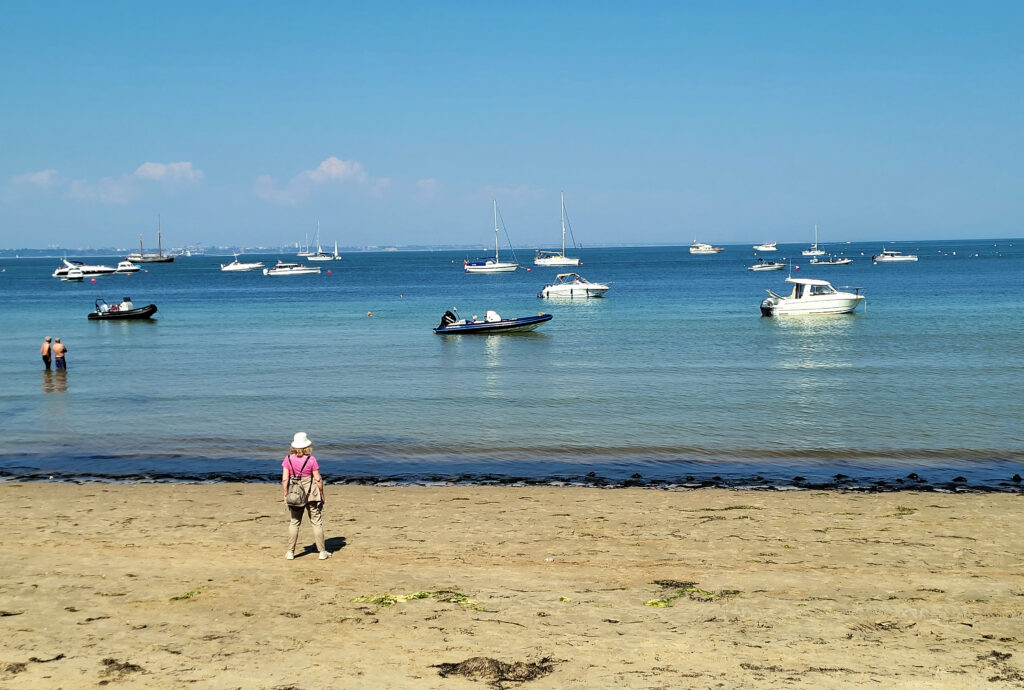
A successful trial of 40 eco moorings in Studland Bay will be expanded to 100 in 2024
External funding sought for eco moorings
Tracey Churcher said:
“We are looking for external funding to put the rest of the hundred eco moorings in and we are hopeful that we will be successful in that bid.
“Recreational boating has been a part of Studland for a long, long time, so for me it is great that we have found a way forward for recreational boaters and beach users and the seagrass to all thrive alongside each other.
“We have representatives of the Royal Yachting Association and local boat clubs on the Studland Bay Marine partnership who are very happy with the location and availability of the eco moorings and how they work – so it is very positive all round.”

Wild beavers are ready to be released into Little Sea as soon as Defra gives the go ahead
Ready to go with release of wild beavers
And Studland may soon have the UK’s first unfenced colony of wild beavers – the National Trust is ‘ready to go’ with the release into Little Sea as soon as Environment Secretary Therese Coffey makes a commitment to the scheme.
As a keystone species, beavers can slow down flooding in an area and also encourage the return of other wildlife, such as water voles – and as Little Sea is surrounded by a nature reserve, the chances of them straying onto any farmed land makes it an ideal site to start with a wild release.
Visitors to Middle Beach can find out more about coastal changes at Studland by visiting the Old Coastguard Hut near the Sandy Salt Pig.
Further information
- More about the National Trust‘s work at Studland Bay



